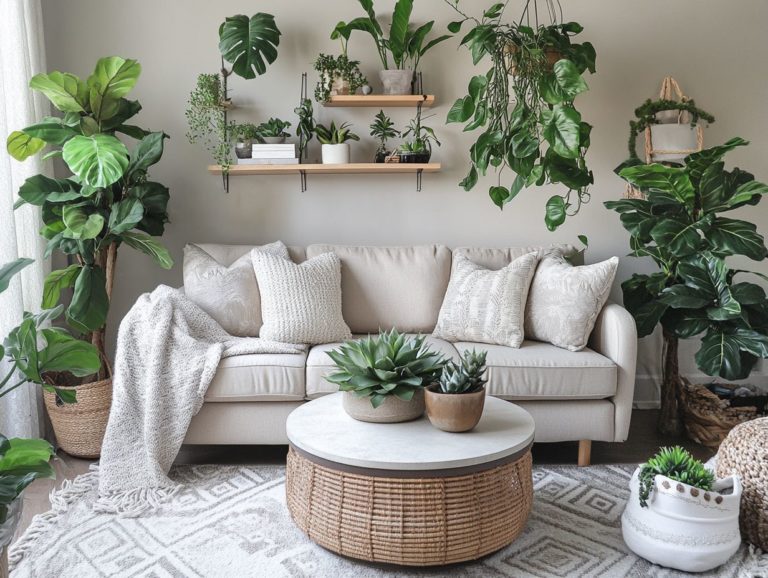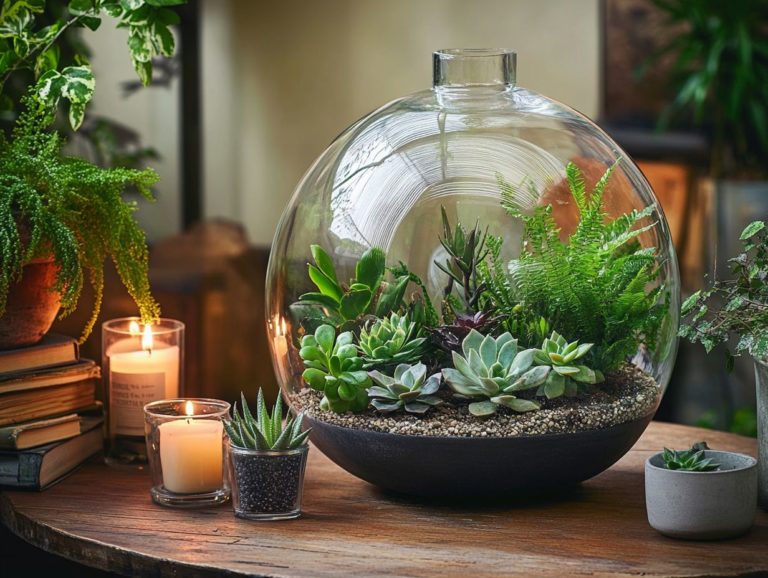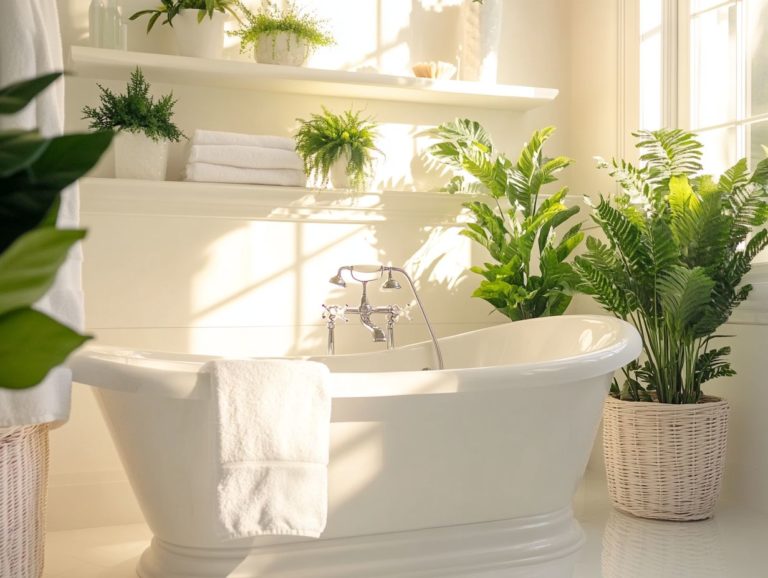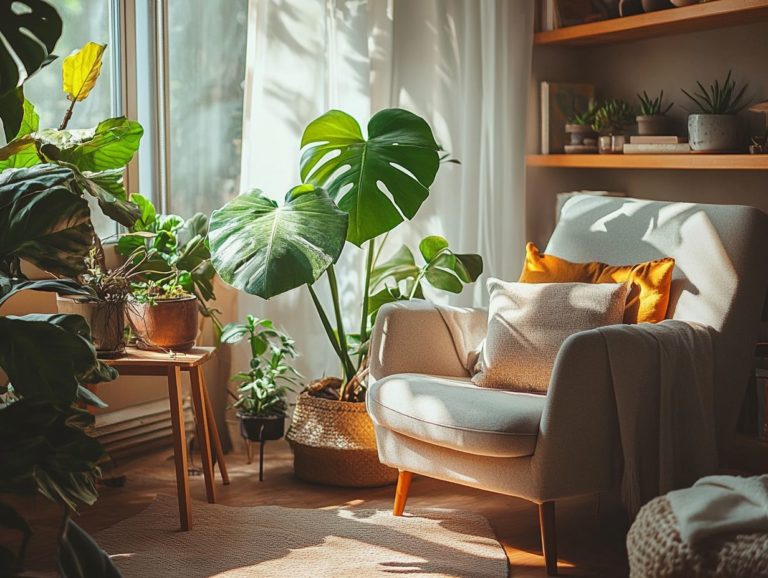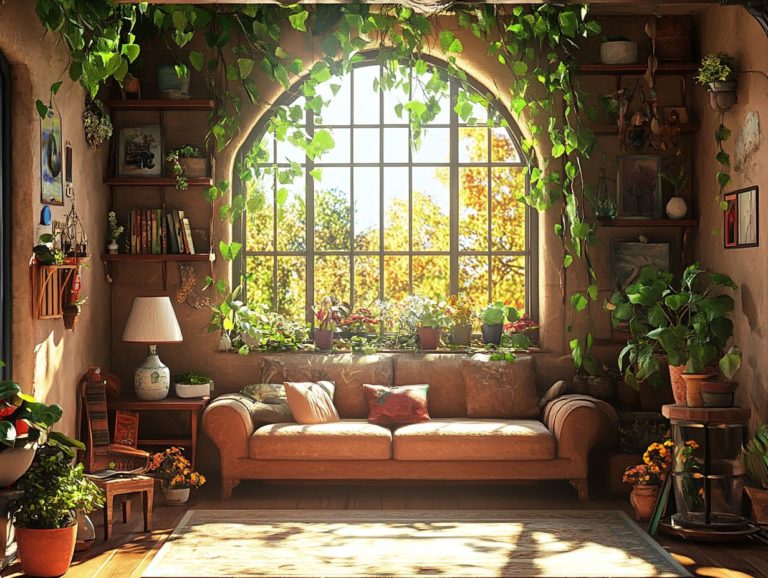Indoor Plants to Use in Your Kitchen Decor
Transforming your kitchen into a vibrant and inviting space is more attainable than you might think. Indoor houseplants serve as the perfect solution.
Imagine culinary herbs that not only elevate your cooking but also include air-purifying varieties that enhance your home’s air quality. These plants not only function beautifully, but they also light up your kitchen with life!
This guide delves into a range of popular options tailored to your kitchen s size, whether expansive or cozy. You ll discover everything from low-maintenance succulents to plants that naturally repel insects, all designed to suit your practical lifestyle.
You ll also learn how to choose, care for, and creatively incorporate these green companions into your kitchen decor. This will result in a refreshing and lively atmosphere that truly transforms your indoor space.
Contents
- Key Takeaways:
- 1. Herbs for Cooking and Aroma
- 2. Air-Purifying Plants
- 3. Succulents for Low-Maintenance
- 4. Hanging Plants for Limited Space
- 5. Plants with Edible Leaves or Fruits
- 6. Plants with Colorful Flowers
- 7. Plants with Interesting Shapes and Textures
- 8. Plants for Humidity Control
- 9. Plants for Natural Insect Repellent
- 10. Plants for Aesthetic Appeal
- How to Choose the Right Plants for Your Kitchen?
- Frequently Asked Questions
- What are the best indoor plants to use in your kitchen decor?
- How do I choose the right indoor plants for my kitchen?
- What are the benefits of having indoor plants in the kitchen?
- Do indoor plants require a lot of maintenance in the kitchen?
- Can I use fake plants in my kitchen decor instead of real ones?
- Are there any indoor plants to avoid using in the kitchen?
Key Takeaways:

- Incorporating herbs in your kitchen decor adds both functionality and aroma.
- Air-purifying plants improve air quality and add greenery.
- Low-maintenance succulents are great for busy individuals.
1. Herbs for Cooking and Aroma
Herbs are not just essential for enhancing the flavors of your cooking; they are aromatic companions that can elevate your kitchen into a sensory haven. Imagine the freshness and greenery they bring, uplifting the atmosphere.
Popular herbs like basil, mint, rosemary, and thyme are perfect for indoor environments. They seamlessly blend practicality with aesthetic appeal in your modern kitchen design.
These herbs do more than just elevate your dishes with their unique flavors; they also contribute significantly to a healthier lifestyle, packed with substances that help protect your body from damage and essential oils. Incorporating them into your kitchen decor is simple whether it s showcasing potted varieties on your windowsill or using decorative herb racks, you can enhance both charm and accessibility.
With just a bit of regular watering and ensuring they soak up adequate sunlight, these low-maintenance plants thrive effortlessly. You’ll have a year-round supply of fresh ingredients!
By integrating herbs into your daily cooking, you ll transform even the simplest meals into delightful culinary experiences, making them invaluable additions to your kitchen.
2. Air-Purifying Plants
Air-purifying plants make for a splendid addition to your indoor space. They are scientifically proven to enhance air quality by filtering out toxins and releasing oxygen, contributing significantly to a healthier living environment.
In your kitchen, these green companions do more than just improve air quality; they infuse a touch of nature that elevates the ambiance. Take the spider plant, for instance. With its graceful arching leaves and charming little white flowers, it thrives in bright, indirect light and manages to flourish even when you forget about it perfect for those of you who are always on the go.
Then there s the snake plant, famed for its toughness and ability to thrive in low-light conditions while requiring minimal watering. The peace lily, with its striking white blooms, prefers a bit more humidity and can happily reside near the sink. Don’t overlook the rubber tree, which not only adds a bold visual statement but also works diligently to purify the air.
Together, these plants deliver both aesthetic pleasure and wellness benefits, crafting a serene atmosphere that inspires culinary creativity.
Start incorporating these wonderful plants today and watch your kitchen transform into a refreshing oasis!
3. Succulents for Low-Maintenance
Succulents are the ultimate low-maintenance plants. They are perfect for busy individuals who want to add a touch of greenery to their kitchens without extensive care. Their diverse shapes and vibrant colors enhance the aesthetic appeal of any decor.
Among popular varieties, you ll find the striking Echeveria and the delightful Haworthia. These plants thrive in well-draining soil and bright indirect sunlight. They purify the air and add unique flair to your kitchen space.
Consider placing them in decorative pots on your windowsills or incorporating them into vertical gardens. With their ability to thrive on minimal water, succulents are ideal companions for those who may forget to water their plants. They blend functionality with style, making your kitchen beautiful and easy to maintain.
4. Hanging Plants for Limited Space
Hanging plants are a smart choice for those with limited space. They infuse your kitchen with vibrant greenery without sacrificing precious countertop or shelf space. This enhances both functionality and decor.
These plants bring a delightful touch of natural beauty while improving air quality. Consider popular choices like the string of pearls and pothos; both thrive in various conditions and require minimal care.
The string of pearls, with its charming bead-like leaves, loves bright, indirect sunlight and needs a drink only when its soil feels dry. Pothos is forgiving and adapts to lower light levels but flourishes in bright, indirect light.
For the best effect, hang them near windows or in corners to create an eye-catching focal point that enhances your kitchen’s design while maintaining a fresh and inviting atmosphere.
5. Plants with Edible Leaves or Fruits
Incorporating plants with edible leaves and fruits elevates your culinary experiences and serves as a sustainable investment in your wellness. Imagine the joy of cooking with fresh herbs and edible plants at your fingertips.
Consider popular indoor plants like basil, mint, and rosemary; these herbs flourish beautifully in your home. They fill your space with delightful aromas and offer a wealth of health benefits, from improved digestion to enhanced flavor in your meals.
The care requirements are refreshingly minimal; most of these plants thrive in a sunny spot with regular watering. Fresh herbs can transform simple dishes into gourmet delights, providing the rewarding experience of home gardening.
Having these living ingredients fosters creativity in the kitchen and promotes a healthier lifestyle by incorporating more nutrient-rich components into your everyday cooking.
6. Plants with Colorful Flowers
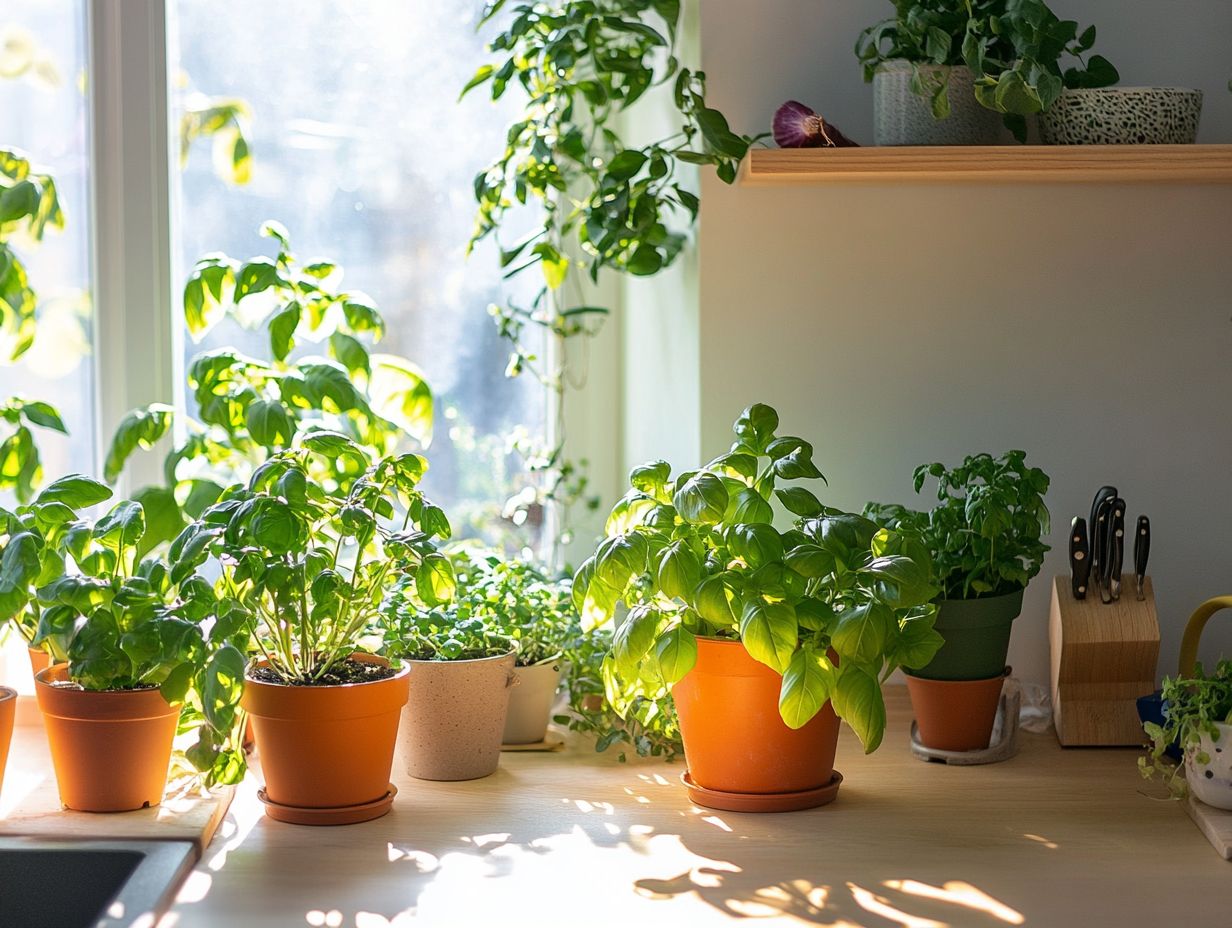
Plants with colorful flowers can transform your kitchen into a vibrant and inviting haven. They infuse your space with a splash of color and beauty that enriches both your cooking experience and overall atmosphere.
Consider adding flowering plants like African violets and begonias to your collection. These beauties adapt well to various indoor environments and have unique care requirements. African violets thrive in bright, indirect light, making them ideal for your kitchen windowsills. For those looking to enhance their space further, exploring the best indoor plants for balcony decor is a great option. Begonias are adaptable and flourish even in lower light conditions.
With proper watering, humidity levels, and the occasional touch of fertilizer, you ll ensure their health and vibrancy. By strategically placing these floral gems on your countertops or shelves, you elevate the aesthetic appeal and invite a touch of nature indoors.
Create a warm and lively cooking space that inspires culinary creativity!
7. Plants with Interesting Shapes and Textures
Plants with captivating shapes and textures can become striking focal points in your kitchen, adding visual intrigue and improving the look of your kitchen all while reaping the benefits of indoor greenery.
The rubber tree shines with its glossy, broad leaves, complementing both modern and eclectic kitchen styles. This low-maintenance gem thrives in indirect sunlight and requires only occasional watering, making it a perfect fit for your busy lifestyle.
Another great option is the kentia palm, with its elegant fronds that infuse a tropical vibe and beautifully soften the hard edges of kitchen spaces. Position these plants near windows or on open shelves to help them flourish while adding an inviting touch to your decor.
Incorporating such greenery brightens your space and cultivates a serene atmosphere, great for inspiring delicious meals!
8. Plants for Humidity Control
Certain plants quickly regulate humidity levels in your kitchen, creating a more comfortable atmosphere and fostering wellness by releasing moisture into the air.
The peace lily is a fantastic choice, with its white flowers and lush green foliage, adapting effortlessly to various indoor environments. The Boston fern is another excellent option; its feathery fronds thrive in higher humidity and add a delightful touch to your space.
Nurturing these green companions means ensuring they receive indirect sunlight and keeping the soil consistently moist just avoid making it soggy. A little misting of the leaves can also boost growth and overall health.
Beyond their visual appeal, these tropical plants enhance indoor air quality by filtering out toxins and producing oxygen. Your kitchen becomes not just a more inviting space but a healthier one as well.
9. Plants for Natural Insect Repellent
Certain plants elevate the aesthetic of your kitchen while acting as natural insect repellents, enhancing your culinary experience and keeping pesky intruders at bay.
Among these, mint and basil are top choices. Mint thrives in partial to full sunlight and prefers moist soil, making it perfect for your windowsill herb garden. Its delightful aroma not only enhances your dishes but also effectively deters flies and ants.
Basil, on the other hand, flourishes in warm conditions with well-drained soil, offering a bold flavor that elevates various cuisines. Both herbs add visual appeal when displayed in decorative pots, infusing your kitchen with charm while reducing unwanted insects.
This combination creates a healthier and more inviting cooking environment for you to enjoy.
10. Plants for Aesthetic Appeal
The aesthetic allure of plants in your kitchen is undeniable; they enhance the visual appeal of the space and cultivate a sense of tranquility and connection to nature, making your cooking experience significantly more enjoyable.
Incorporating a variety of greenery can transform a mundane kitchen into a vibrant sanctuary. Consider adding herbs like basil and rosemary, which infuse your space with a refreshing scent and are practical for your culinary adventures. Leafy plants such as pothos or ferns can soften hard edges and add an element of elegance. For seasonal decor, check out the top 5 indoor plants that can enhance your home’s aesthetic.
Embracing diverse design styles from minimalist terrariums to rustic window boxes allows you to customize your kitchen decor to fit your unique taste. Creative displays, such as hanging planters, wall-mounted pots, or a vertical garden, optimize your space while enhancing visual intrigue with the best indoor plants for entryway decor.
Ultimately, introducing this lush greenery elevates not only the aesthetic but also contributes to a healthier, more inviting atmosphere conducive to both cooking and relaxation.
How to Choose the Right Plants for Your Kitchen?
Choosing the right plants for your kitchen requires a keen understanding of your indoor environment, including critical factors like light, humidity, and temperature. By doing this, you ensure the plants you select not only thrive but also elevate your cooking experience.
Assessing these conditions is essential. It allows you to select plants that can flourish under varying light availability, from brightly lit windowsills to shadier countertops. Also, think about the humidity levels in your kitchen. Some edible plants, like basil and cilantro, thrive in moist air, while others might prefer a drier atmosphere. Additionally, consider using indoor plants for seasonal decor to enhance your space.
Understanding the care requirements such as watering frequency and the type of soil can greatly impact your plants health. For practical tips, start with hardy varieties like herbs. They not only enhance your culinary creations but are also generally forgiving for those new to gardening.
By taking this thoughtful approach, you can grow a beautiful kitchen garden that complements both your cooking endeavors and your living space.
What Are the Best Placement Options for Kitchen Plants?

The effective placement of your kitchen plants is vital for their growth and longevity, ensuring they bask in just the right amount of light, whether direct or indirect. This attention to detail enhances both their health and the aesthetic charm of your kitchen.
Choosing the perfect spot, like windowsills or countertops, can make a significant difference. For instance, herbs such as basil and parsley flourish in bright, direct sunlight, making a south-facing windowsill the ideal perch for them.
On the other hand, succulents prefer indirect light, so a countertop near a north-facing window could be just the ticket. It s important to keep a close eye on your leafy companions, adjusting their placements as the seasonal light patterns shift.
A thoughtfully arranged space not only promotes optimal growth but also creates a vibrant, inviting cooking environment where fresh ingredients spark your creativity in the kitchen.
How to Care for Your Kitchen Plants?
Caring for your kitchen plants requires a delicate balance of watering, soil quality, and understanding the unique needs of each plant. This helps you maintain a thriving indoor garden and enhances your culinary and decor endeavors.
To achieve this balance, it’s crucial to establish a watering routine that keeps the soil consistently moist, yet never waterlogged. Most herbs, like basil and cilantro, thrive in well-draining soil enriched with organic matter, allowing excess water to escape freely.
Monitor your plants’ health by inspecting for yellowing leaves, which may signal overwatering, or wilted foliage that suggests they need a bit more hydration. By familiarizing yourself with the watering frequency and soil requirements of individual plants, such as rosemary or mint, you can cultivate an environment that fosters growth while elevating your kitchen’s aesthetic and functionality.
What Are the Benefits of Having Plants in Your Kitchen?
Incorporating plants into your kitchen brings an array of benefits that elevate your space, from enhanced air quality to a touch of elegance, all while positively influencing your overall wellness. It’s a decision that truly enriches any home.
Surrounding yourself with greenery does wonders. Not only do plants like spider plants and peace lilies purify the air by filtering out harmful toxins, but they also infuse your kitchen with life and vibrancy. Exploring the benefits of using indoor plants in your decor can enhance your space even further. The mere act of nurturing these living beings fosters a deep sense of tranquility and connection to nature, significantly reducing stress and promoting a brighter mood.
Herbs like basil and mint serve as culinary delights while releasing invigorating fragrances that transform your cooking experience. Ultimately, the blend of visual charm, health advantages, and emotional uplift makes the choice to incorporate plants into your kitchen a remarkable investment in your home and well-being.
Start growing your kitchen garden today to enjoy fresh herbs in your meals!
What Are the Common Mistakes to Avoid When Using Plants in Kitchen Decor?
Many individuals stumble into common pitfalls when integrating plants into their kitchen decor. They often overlook essential factors like proper care and suitable placement, which can significantly impact plant health and overall aesthetic appeal.
Overwatering is a prevalent issue. Many mistakenly believe that more water equals more robust growth, leading to root rot and other problems.
Poor lighting conditions can also harm your plants. Too little or too much sunlight can cause wilting or scorching.
Each plant has unique care requirements. For example, some herbs thrive in bright, indirect light, while larger leafy plants need more space and less intense rays.
Get to know your plants needs to create a vibrant green space in your kitchen!
How to Incorporate Plants into Your Kitchen Decor?
Incorporating plants into your kitchen decor creates a harmonious blend of nature and design. This enhances the overall atmosphere and improves air quality.
Use hanging baskets to draw the eye upwards, maximizing vertical space. Window shelves filled with herbs provide convenient access for cooking and introduce delightful scents.
Counter displays featuring vibrant potted plants act as bold focal points. They breathe life into minimalist spaces and pair beautifully with various decor styles.
Integrating this lush foliage not only enhances visual appeal but also fosters tranquility in your daily life.
Frequently Asked Questions
What are the best indoor plants to use in your kitchen decor?
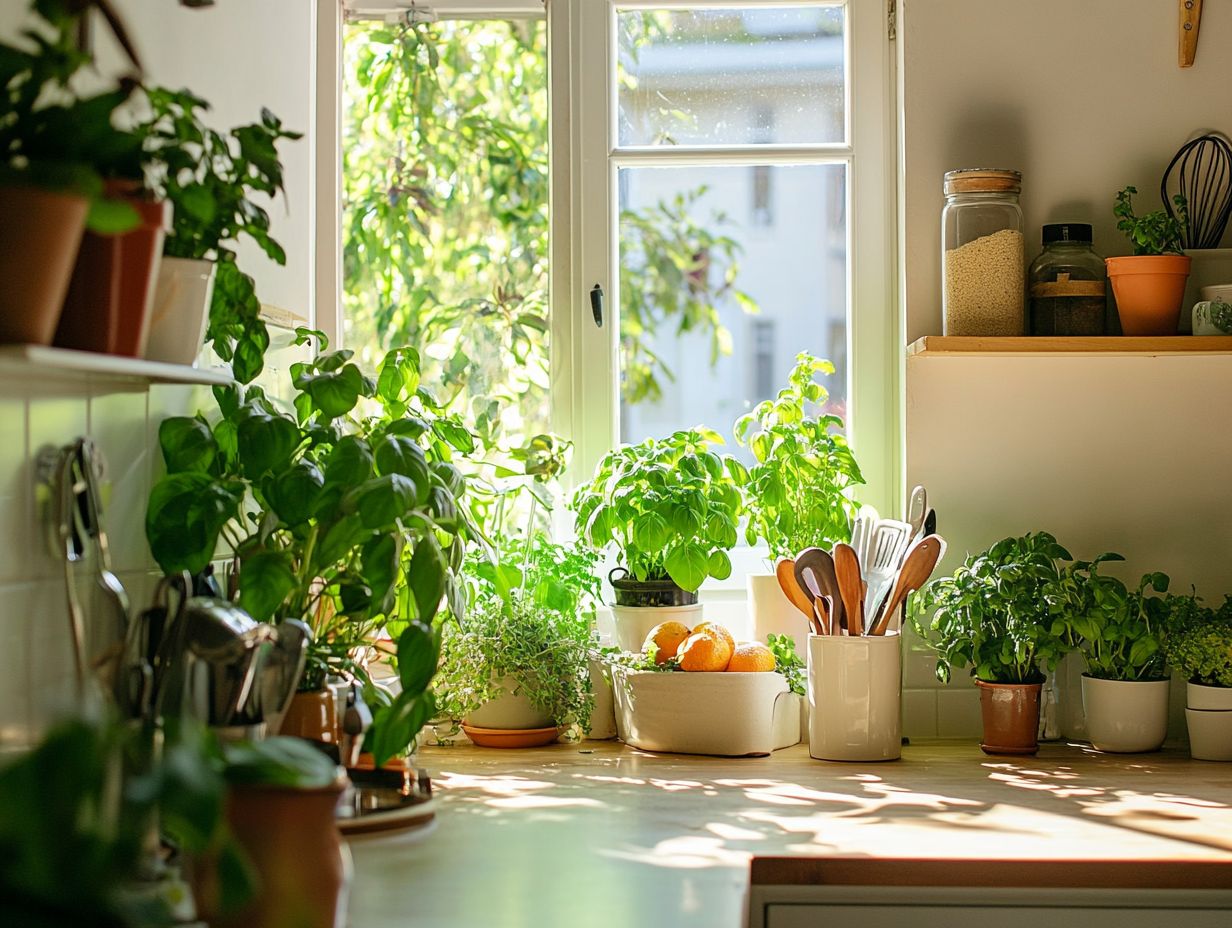
Popular options include herbs like basil, rosemary, and thyme, as well as succulents, pothos, and spider plants.
How do I choose the right indoor plants for my kitchen?
Consider how much natural light your kitchen receives and the space available for plants. Low-light tolerant plants work best for kitchens with minimal sunlight.
What are the benefits of having indoor plants in the kitchen?
Indoor plants purify the air, add color, and provide easy access to fresh herbs for cooking. For example, a coffee plant enhances the aesthetic while being functional.
Do indoor plants require a lot of maintenance in the kitchen?
Not necessarily! Some plants, like succulents and cacti, thrive with minimal care. Regular watering and fertilizing, especially for plants like aloe vera and Boston fern, are essential to keep them healthy.
Can I use fake plants in my kitchen decor instead of real ones?
Fake plants might look easy to care for, but they can’t match the benefits of real ones. Choose plants like African Violet and Rubber Tree for a healthier and more attractive kitchen.
Are there any indoor plants to avoid using in the kitchen?
Yes, some indoor plants can be poisonous if eaten. Avoid plants like Philodendron, Pothos, and Peace Lily to keep your kitchen safe.
Make sure to research plants before you decorate! Always check resources like the ASPCA for safety information.

